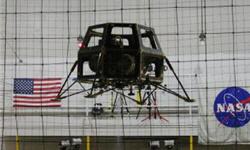
© NASA/Ames Research Center
In an old paint hangar here, NASA's Ames Research Center has its Hover Test Vehicle (HTV) encased in web safety netting as it perfects the control software that will allow the simple spacecraft to land and hop around on the lunar surface.
The 68-kilogram (150-pound) HTV is a step toward fulfilling what Ames director S. Pete Worden, a veteran of the Air Force's Clementine minisat mission and fast-paced Responsive Space Program, envisions for quick, cheap missions to the moon, rendezvous with asteroids, Earth observation or any of a dozen other space chores.
Shortly after he took the helm at Ames, Worden launched the Common Spacecraft Bus development program for orbiter or lander missions that would cost less than $50 million and could be done, from design-to-launch, in two years or less.
Ideas are flowing on how such a bus might fulfill NASA missions, particularly for the Lunar Science Institute that Ames manages and the International Lunar Network (ILN) headquartered at NASA's Marshall Space Flight Center in Huntsville, Alabama.
On the private space front, Odyssey Moon Ventures will tap the Common Spacecraft Bus team for technology as it pursues the $30 million Google Lunar X-Prize (Aerospace DAILY, Sept. 14).
The 12-member spacecraft development team took just eight months from design to production for the HTV. The prototype uses common industrial and commercial products -- including compressed gas cylinders instead of a bipropellant propulsion system and a crash sensor from a BMW for a motion sensor -- as it adapts the Mathworks Matlab numerical software for descent control.
Alan Weston, chief of spacecraft design, expects to ship the HTV to Marshall by late this year or early 2009 for technology transfer tests to support the International Lunar Network program. The ILN initiative is backed by NASA, the European Space Agency and seven other spacefaring nations to develop multinational missions.
Ames' first application of the Common Spacecraft Bus is expected to be for its own Lunar Atmosphere and Dust Environment Explorer (LADEE) mission, which is set for launch in 2011.
The bus uses a combination of modules to fulfill varying missions, from a basic "feather weight" version weighing about 50 kilograms (110 pounds) to "small" (up to 130 kilograms, or 290 pounds) and "orbiter" size of 150-200 kilograms (330-440 pounds). The difference is how many extension modules are added to the basic payload module.
Launch possibilities vary. A Minotaur 5-class vehicle would be appropriate for government customers. The extended version of Falcon 1 proposed by SpaceX could work for civil payloads, although the company isn't focused on that vehicle currently.
Low cost, quick response spacecraft lend themselves to NASA's Small Explorer Program to tackle asteroid rendezvous, lunar atmosphere studies and other robotic endeavors, where quick reaction and low-cost make the whole thing possible. As it did on LCROSS (Lunar Crater Observation and Sensing Satellite), Weston expects Ames will partner with Goddard Space Flight Center on most of them for the science mission and with contractors for hardware development.
"The contractor has the infrastructure," he says. "We don't. But we can design the mission. I see the [concept] catching on, slowly but surely."

Reader Comments
to our Newsletter